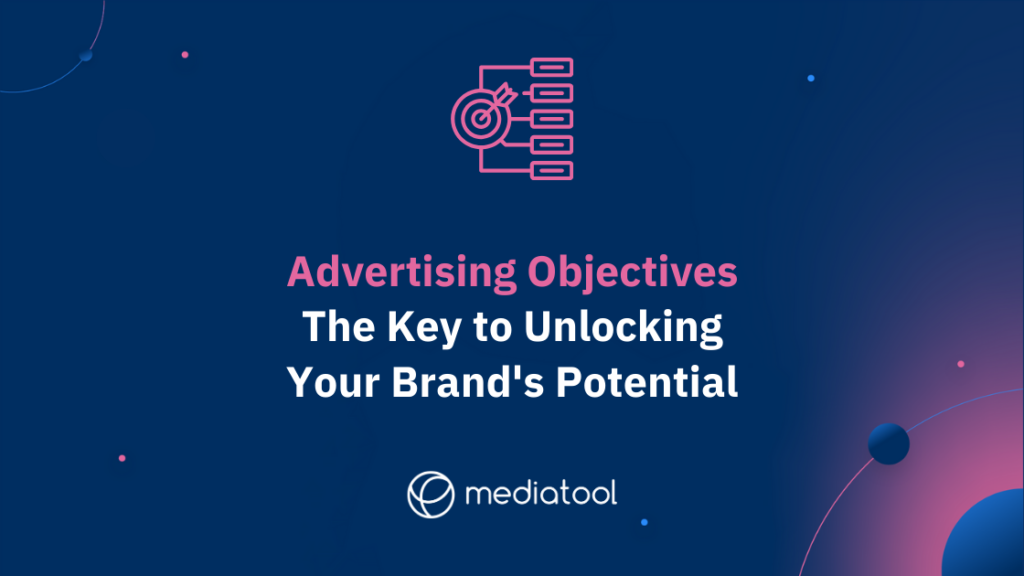Establishing effective advertising objectives has never been more critical in today’s fiercely competitive market. Brands everywhere are grappling with the question: How do we cut through the noise, capture attention, and drive meaningful engagement? This dilemma is compounded by the ever-changing landscape of consumer preferences and digital innovations.
But here’s the twist: while this challenge can seem daunting, it’s also an incredible opportunity. With the right approach to advertising objectives, your brand can stand out and build lasting connections with your audience.
In this article, we’ll navigate the maze of setting, evaluating, and adjusting your advertising strategies. You’ll discover how to craft objectives that resonate with your target audience, align with your brand’s core values, and ultimately drive success in this dynamic marketing world.
What are Advertising Objectives?
Advertising objectives are the strategic goals that steer a brand’s advertising campaigns toward success. These objectives, whether they focus on digital advertising or conventional advertising, play an important role in determining how a brand communicates with its target audience.
They’re not just about creating flashy banner ads or engaging digital ads; they’re about crafting a message that resonates with potential and existing customers, driving brand building, and increasing brand awareness.
In digital marketing, advertising objectives often involve reaching a wider audience through online platforms, fostering brand loyalty, and acquiring customers. By setting clear objectives, brands target value creation by attracting prospective customers, encouraging brand switching, and enhancing brand image.
This approach allows for more effective marketing communication and ensures that every advertising campaign contributes meaningfully to the brand’s overall value creation.
For companies that bypass traditional advertising venues, objectives might include creating a strong online presence, utilizing social ads, and tapping into niche marketing opportunities. The goal is always to establish a connection with the audience—whether through informative advertising, entertaining advertising, or reminder advertising—that leads to acquiring more customers and, ultimately, increasing sales naturally.
By regularly assessing and refining these objectives, brands can ensure that their advertising efforts are not just a random shot in the dark but a targeted, strategic approach to growing their market share and establishing a dominant position in their industry.
Why are Advertising Objectives Set?

Guiding the Brand’s Direction
Setting advertising objectives is crucial for steering a brand toward its goals. These objectives act as a compass, guiding advertising campaigns to align with the brand’s overall mission. Whether focusing on digital marketing or conventional advertising, clear objectives help brands navigate through the clutter of the advertising world.
They ensure that every campaign, whether it involves television, digital, or even banner ads, contributes effectively to the brand’s broader aim of building a strong, recognizable image.
Effective Resource Allocation and Measurement
Having well-defined advertising objectives aids in the efficient use of resources. Brands can allocate their budget and efforts where they will have the most impact, such as online advertising or niche marketing strategies.
Objectives provide a metric for measuring the success of advertising campaigns, allowing brands to assess whether they are increasing brand awareness, acquiring new customers, or enhancing brand loyalty. This focus prevents brands from investing in advertising that fails to contribute to their overarching goals.
Connecting with the Target Audience
In today’s crowded advertising landscape, where consumers are inundated with messages from various brands, having precise objectives helps a brand stand out. These objectives ensure that advertising campaigns are tailored to the needs and interests of the target audience, making it more likely that potential customers will engage with the brand.
Notably, 82% of marketers recognize the importance of having high-quality data about their target audience for success in their roles, yet more than half report a lack of essential information about their audience. This highlights the critical need for in-depth understanding of the target audience in shaping successful advertising campaigns.
Effective advertising objectives enable brands to create meaningful connections with their audience, whether through informative advertising, entertaining content, or reminder advertising, leading to more customers and stronger brand recall. By focusing on gathering and using detailed audience data, brands can fine-tune their advertising objectives to more effectively connect with and engage their target market.
Adapting to Market Changes
Finally, setting advertising objectives allows brands to remain agile and adapt to changing market conditions. In an era where digital advertising is constantly evolving and consumers’ preferences shift, having clear objectives helps brands stay relevant and responsive.
It enables brands to refine their strategies, whether they’re looking to attract prospective customers, encourage brand switching (when a customer switches brands), or reinforce their brand image, ensuring that their advertising efforts are always aligned with their ultimate goals.
10 Objectives of Advertising

In the dynamic marketing world, setting clear advertising objectives is fundamental for any brand aiming to make a significant impact. These objectives act as guiding stars, illuminating the path to successful brand building, customer engagement, and market dominance.
Whether through digital marketing or traditional advertising methods, each objective addresses a specific aspect of the brand’s strategy. Here are ten key advertising objectives that can propel a brand to new heights:
1. Increase Brand Awareness
One of the primary advertising objectives is to make your brand a household name. This involves creating campaigns that resonate with your target audience, enhancing brand recall, and establishing a strong brand image. Through digital advertising and traditional methods, increasing brand awareness ensures your brand is recognized and remembered.
In line with this goal, 45% of marketers plan to boost their investment in content that showcases their brand’s values, while 43% will maintain their investment level from 2023. This trend highlights the growing emphasis on content that not only reaches but also resonates with audiences, reflecting a brand’s ethos and strengthening its identity in the marketplace.
2. Generate Leads
Attracting potential customers is crucial for any business. By generating leads, advertising aims to draw in those who have shown interest in your products or services. This objective is often achieved through targeted marketing communication, using both digital and traditional advertising methods.
3. Drive Sales
The end goal of many advertising campaigns is to convert leads into actual sales. This objective is about moving potential customers along the buying journey, from awareness to purchase, ultimately boosting the company’s bottom line.
4. Boost Brand Loyalty
Fostering brand loyalty means creating long-term relationships with your customers. This objective involves repeated advertising, premium marketing strategies, and delivering quality products that encourage customers to stay loyal to your brand.
It is estimated that approximately 70% of global customers exhibit loyalty towards at least one brand or company. This statistic underscores the significant potential for brands to cultivate loyalty among their customer base. By consistently delivering on brand promises and maintaining a high standard of quality, you can effectively nurture a loyal following that not only continues to choose your brand but also advocates for it.
5. Educate the Market
Informative advertising plays a key role in educating the market. This objective is about providing valuable information to consumers about your products or services, helping them understand why they need what you’re offering.
6. Create Brand Preference
Through advertising, brands aim to position themselves as the preferred choice over competitors. This involves targeting specific aspects of your brand that appeal to your audience and highlighting them in your advertising campaigns.
7. Encourage Brand Switching
A key advertising goal is to persuade customers to switch from their current brands to yours. This objective targets those who are already purchasing similar products but have yet to choose your brand.
Significantly, 66% of customers who switch brands are motivated by better deals, and 58% by superior product quality. These factors highlight the effectiveness of focusing on value and quality in your advertising to encourage brand switching.
By showcasing what sets your brand apart, such as competitive pricing or exceptional product quality, you can effectively attract customers open to exploring new options. Advertising that emphasizes these advantages can be a powerful tool in persuading consumers to switch to your brand.
8. Improve Brand Image
Enhancing your brand’s public perception and reputation is a vital advertising objective. This involves crafting campaigns that positively reflect your brand’s values and ethos, contributing to a stronger overall brand image.
It’s worth noting that maintaining a consistent brand presentation across all platforms can lead to an increase in revenue of up to 23%. This underscores the importance of coherence in brand messaging and visual identity across different media channels. A unified brand image strengthens customer recognition and trust, which are essential for building a positive reputation and growing your business.
9. Target Niche Markets
Focusing on specific market segments with tailored advertising is essential for niche marketing. This objective involves understanding these segments’ unique needs and preferences and creating campaigns that speak directly to them.
10. Support Other Marketing Efforts
Advertising objectives should also include supporting and complementing other marketing activities. This holistic approach ensures that all efforts are cohesive and work together towards the brand’s overall strategy.
How to Determine Advertising Objectives?
Identifying the optimal advertising objectives for your brand is a crucial step in crafting a successful marketing strategy. This process demands an in-depth analysis of your market, an understanding of your brand’s unique value, and a keen insight into the needs and behaviors of your target audience. Here are the key steps in determining your advertising objectives:
Analyzing Market Trends and Customer Behavior
To set effective advertising objectives, it’s essential to stay attuned to the latest market trends and understand your customers’ evolving preferences. This involves researching how your target audience interacts with digital and traditional media and observing how other brands in your industry position themselves.
Whether it’s an increase in online advertising, a shift towards premium advertising, or new patterns in customer behavior, staying informed helps you set relevant and impactful objectives.
Aligning Objectives with Brand Goals
Your advertising objectives should directly contribute to your own brand building goals overall. This means aligning your campaigns with your brand’s mission and values, whether you’re aiming to increase brand awareness, enhance brand recall, or encourage customers to switch brands.
Consider what makes your brand unique, such as your premium product line or commitment to delivering quality products, and use these strengths to inform your advertising aims.
Balancing Digital and Traditional Advertising
In today’s diverse media landscape, balancing digital advertising with traditional methods is essential. While digital ads, social ads, and online advertising offer vast reach and targeting capabilities, traditional advertising venues like television and print still hold significant value, especially in building brand equity and reaching broader audiences.
A mix of digital and traditional advertising ensures you engage with your audience through multiple channels, maximizing the impact of your campaigns.
Creating Measurable and Achievable Objectives
Finally, ensure that your advertising objectives are both measurable and achievable. This involves setting specific, quantifiable goals for each advertising campaign, whether attracting a certain number of new customers, achieving a specific level of sales, or enhancing the perception of your brand.
By creating clearly measured objectives, you can assess the effectiveness of your advertising efforts and make informed adjustments as needed.
By following these steps, you can determine advertising objectives that are not only aligned with your brand’s goals but also adaptable to the changing landscape of the market and the preferences of your audience.
Evaluating and Adjusting Advertising Objectives
The Importance of Continuous Evaluation
Regular evaluation of advertising campaigns is essential to gauge their effectiveness. Brands must track key metrics, such as engagement and conversion rates, to understand whether their advertising objectives are being met.
For instance, if a premium brand regularly advertises to acquire customers, analyzing campaign data will reveal how effectively the ads attract potential buyers. Constant advertising also allows brands to create rational and emotional connections with their audience, but without evaluation, efforts might waste money without yielding desired results.
Adapting to Market Feedback
Advertising strategies must evolve based on customer feedback and market trends. For example, if a telecom company launches plans that aren’t resonating with the target audience, it may need to adjust its advertising campaigns. Similarly, brands targeting value creation should be ready to pivot their strategies if customers switch brands or if the market shows greater interest in a different product line.
Leveraging Data for Strategic Decisions
Data analytics is a powerful tool in advertising. Brands can use data from their campaigns to make informed decisions on future advertising strategies.
This might involve shifting focus to online platforms if digital advertising shows higher engagement or investing more in sponsored ads if they lead to higher brand recall. By leveraging data, brands can optimize their advertising spend and focus on strategies that drive real value.
Case Studies and Examples
Incorporating case studies can illustrate successful adjustments in advertising objectives. For example, a case study might showcase how an existing brand, known for its very premium product line, revamped its advertising after realizing that repeated advertising creates more brand loyalty.
Another example could be how a parent brand of ice cream brands adjusted its advertising strategy after noticing that link ads were more effective in attracting customers than television ads.
Conclusion
Let’s look ahead as we close this deep dive into advertising objectives. The advertising landscape is ever-evolving, with new technologies and shifting consumer behaviors constantly reshaping how brands communicate with their audiences. In this dynamic environment, the ability to set, evaluate, and adjust advertising objectives will be more critical than ever.
Brands that stay ahead of the curve will be those that not only understand their current market and audience but also anticipate future trends. They will be the brands that embrace both the power of digital advertising and the enduring impact of traditional media, weaving them together in innovative ways to create compelling narratives that resonate with consumers.
As we move forward, the brands that will thrive are those that see advertising not just as a tool for sales but as a means to build lasting relationships with their customers, contribute positively to society, and create a legacy beyond mere profit.
These brands will be the ones that remember that at the heart of all these ads, strategies, and objectives is the human connection — the ultimate goal of any advertising endeavor.





